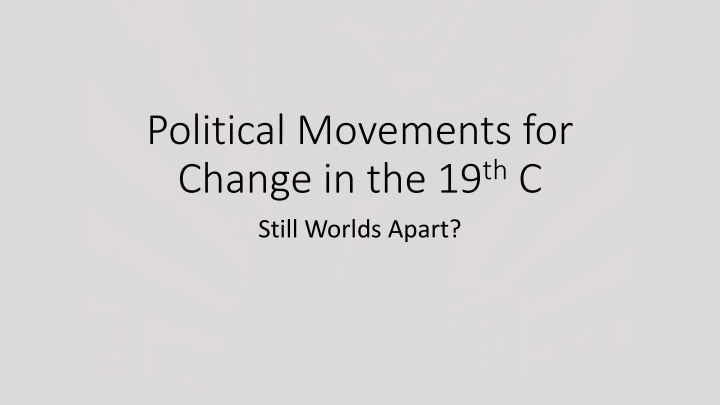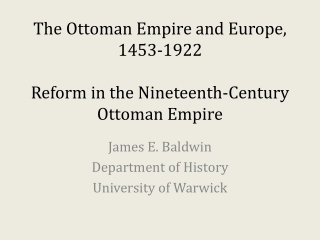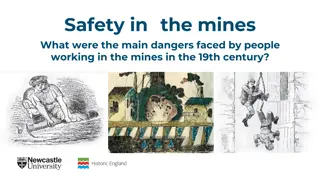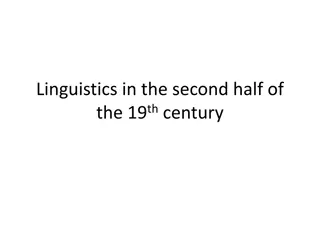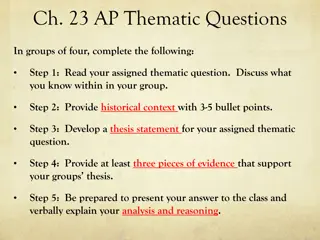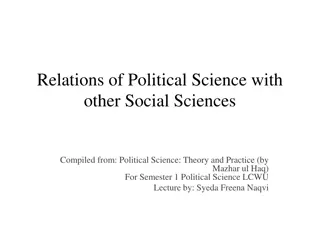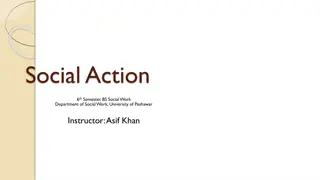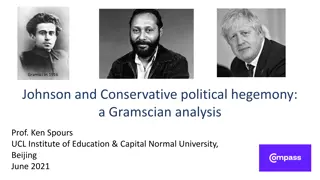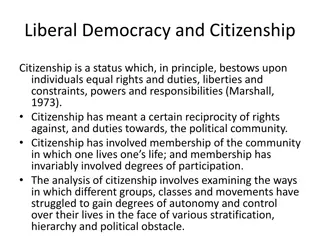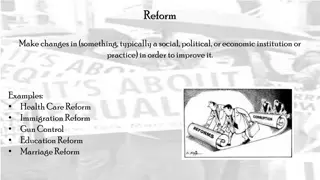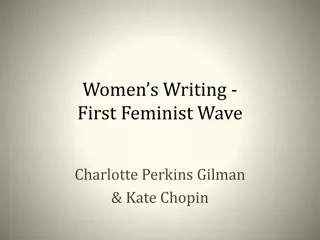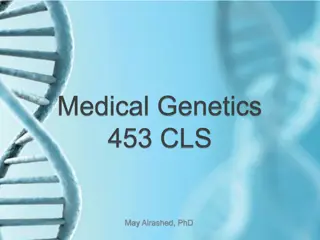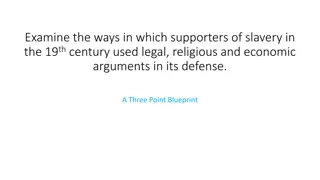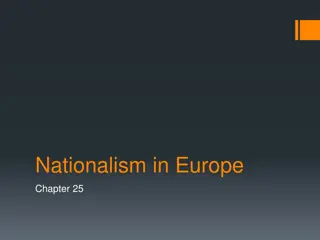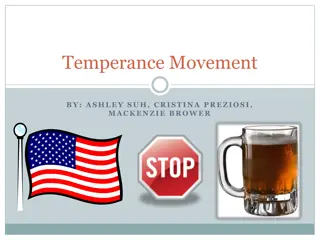Political Movements for Change in the 19th Century
Reactions to social and political change, European positions, and radicals in Europe during the 19th century reflect a period of significant upheaval, diverse ideologies, and quests for reform and revolution. Movements from around the world, including Europe, North America, and India, sought to challenge existing powers and establish new societal norms. Despite differing positions, these movements collectively aimed for greater freedoms and societal transformations, leading to a complex era of political evolution.
Download Presentation

Please find below an Image/Link to download the presentation.
The content on the website is provided AS IS for your information and personal use only. It may not be sold, licensed, or shared on other websites without obtaining consent from the author.If you encounter any issues during the download, it is possible that the publisher has removed the file from their server.
You are allowed to download the files provided on this website for personal or commercial use, subject to the condition that they are used lawfully. All files are the property of their respective owners.
The content on the website is provided AS IS for your information and personal use only. It may not be sold, licensed, or shared on other websites without obtaining consent from the author.
E N D
Presentation Transcript
Political Movements for Change in the 19thC Still Worlds Apart?
Reactions to Social and Political Change The political and economic transformations of the late eighteenth and early nineteenth centuries had people and communities question how to define and rule territories and what social and cultural visions to embody o In Europe, political and economic revolutions overturned the old order o In North America, the United States expansion west led to dispossession of Native American land and the loss of Mexican territories o Indigenous peoples such as the Maya struggled against the demands of the nation-state and those of new imperial powers o India saw one of the biggest armed uprisings ever in its history of 5000 years, directed against British rulers oWhile all movements were against the status quo and sought greater freedoms, there was little to no coordination oIn terms of people s history this was still the era of Worlds Apart
European Positions in the early 19thC Three contending positions in response to the Europe created by the Congress of Vienna that restored the powers of old regimes swept away by the revolution and Napoleon s conquests Reactionaries wanted a return to the traditionally ordered societies that existed prior to the French Revolution Liberals were OK with the political and legal changes of the Revolution, but opposed Jacobin-style attacks on property. They pushed for reforms to limit the power of government and the church and promote the rights of individuals and free trade Radicals convinced that real change was only possible by going to the root (in Latin, radix) of the problem, and were products of different ideas, some religious, others nationalists, and yet others, Socialists
Radicals in Europe In a new era dominated by conservative monarchies, radicals, liberals, utopian socialists, nationalists, abolitionists, and religious leaders organized to create a better world Restoration and resistance o The social and political unrest between 1815 and 1848, the Restoration period, stemmed from the ambiguous legacies of the French Revolution and the Napoleonic wars Radicals envisioned total reconfiguration of the old regime s state system, continuing the revolution They shared an agenda for popular sovereignty but were a diverse lot with much dissent
Radical Visions: Nationalists Nationalism was important to liberals and radicals but a threat to conservatives Radicals defined the people as those who shared a common language and common history Each nationalist movement drew backers from the liberal aristocracy, the well- educated and commercially active middle classes, and university students Nationalists demanded new nation-states in Poland, Serbia, Greece, Italy, and Germany, each in slightly different forms Inspired by religious revivalism and enlightenment ideals, Greece secured its independence from the Ottoman Empire in the 1820s Most nationalist movements were suppressed or slow to accomplish change
Radical Visions: Socialists and Communists Socialists and communists were concerned about the inequalities produced by industrial capitalism and worried: o About the economic gap between impoverished workers and the new wealthy employers o That the division of labor common with the industrial revolution would make people into soulless, brainless machines They argued that the whole free-market economy had to be transformed to save human beings from self-destruction, not just the state Ordinary workers, artisans, domestic servants, and women in manufacturing joined radical prophets in staging strikes, riots, peasant rebellions, and protests to campaign for economic, social, and political equality
Radical Visions: Fourier and Utopian Socialism Charles Fourier (1772 1837) and his utopian socialism was the most visionary of all alternative movements Fourier, a former cloth trader, thought of himself as the scientific prophet of a new utopian world created through organization rather than bloodshed o 1808: created a system, Fourierism, which advocated for reorganizing society into phalanxes or communities of about 1,500 people o All members of the phalanx would work in short spurts of two hours in varied tasks, and undesirable work would fall to adolescents Fourier s writing gained popularity in the 1830s o Women worked toward social and moral reform, and viewed Fourier s system as a higher form of Christian communalism o His writings influenced Russians such as Fyodor Dostoevsky, Italians such as Giuseppe Mazzini, the Spanish republican Joaquin Abreu, and the German Karl Marx
Radical Visions: Marxism (Scientific Socialism) Karl Marx (1818 1883) became the most important Restoration-era radical Collaborating with Friedrich Engels (1820 1895), who wrote The Condition of the Working Class in England, they developed scientific socialism o They argued that what mattered in history were the production of material goods and the ways in which society was divided into producers and exploiters o They claimed that history consisted of successive forms of exploitative production and rebellions against them o Marxists believed the current clash between wage workers, proletarians, and capitalists would usher in a brave new world of true liberty, equality, and fraternity o A proletarian revolution would create a dictatorship of the proletariat and the end of private property o The state would wither away because there would be no need for human exploitation o History moved through stages: feudalism to capitalism, socialism, and finally communism
Radical Visions and the Revolutions of 1848 The revolutions of 1848 resulted in uprisings in France, Austria, Italy, and Czechoslovakia, but they were crushed by the reactionary crackdowns; still, radical visions continued to shape views of alternatives Revolutions in the states of the German Confederation ober 1848-49 revealed popular support for pan-Germanism, and opposition to the autocratic political structure of the states of the Confederation Differences among the revolutionaries: middle-class elements were committed to liberal principles, while the working class sought radical improvements to their working and living conditions, peasants fought for the abolition of serfdom As the middle class and working class components of the Revolution split, the conservative aristocracy defeated it. Liberals were forced into exile to escape political persecution The Revolutions though, were successful in the final abolition of serfdom in Germanic states Marx published The Communist Manifesto in 1848, calling on the workers of all nations to unite and overthrow capitalism
Communist Manifesto : Questions What do Marx and Engels mean by The history of all hitherto existing society is the history of class struggles ? Transitions of history can be explained through class struggle, from feudalism to capitalism and the expected one from capitalism to socialism How did industrial capitalism simplify class antagonisms ? Society as a whole is more and more splitting up into two great hostile camps, into two great classes directly facing each other Bourgeoisie and Proletariat Working in factories allows workers to come together, organize (contrast with peasants) Is the Manifesto only a critique of the bourgeoisie? No, see pg. 16 (last para) to pg. 17 purple prose praising the bourgeoisie But pg. 17-18 shows how capitalism and the bourgeoisie are *holding up* productive forces, leading to waste, to periodic crises etc Thus, a scientific critique of capitalism, and the inevitability of its collapse
Communist Manifesto: Impacts and Limits Huge impact on working class organization and labor: much of what we know as labor laws, social welfare programs and the like are a direct product of that struggle Contributed to significant change (revolutions) in Russia, in China, in Cuba and indirectly shaped many other nationalist movements in the colonial world But, evidently, the analysis of the inevitable decline of capitalism was flawed Did not take into account the power of nationalist ideas: The call of Working Men of All Countries, Unite! did not work out, and proletarians across the world did not accept that they had nothing to lose but their chains As a result, nor did they have a world to win Yet, the method of understanding and explaining history that Marx and Engels demonstrate, e.g. how they explain the shift from feudalism to capitalism, remains valid, and even non-Marxist historians apply the method of historical materialism seen in the document
break to start group formation for final project Use time to reach out to form groups voluntarily If you have one or two people you know you want to work with, make that the core of a group and call out for others Having a topic or theme will make this easier. Share your interest in topics and themes, and see if you can interest enough people to come together If you already have a group, discuss topics, refine the topic, and/or select a leader Group creation cannot be done in 10 minutes, START the process now and follow up on the DISCUSSION FORUM Need a list of groups and topics by NEXT TUESDAY
Rebels against Colonialism All attempted revolution was not necessarily class war In many contexts, particularly under colonial rule, indigenous groups sought to turn back to traditions to overthrow colonial rulers Like Wahabbism or the Taiping movement (discussed on Tuesday), although claiming to return to tradition or a result of a vision, these were actually NEW responses to dispossession, defeat, and decline We will focus on the United State and India, but the Caste War in the Yucatan (Mexico) and the Mayas fight for autonomy demonstrates many similar features
Dissidents and Rebels In North America, the United States expansion west by late 19th C, led to almost all American Indians being confined to reservations Alternative to the expanding United States: Native American prophets oEarly calls for resistance and a return to tradition In 1805, Shawnee Prophet Tenskwatawa foretold how invaders would vanish if American Indians returned to their customary ways and traditions He claimed that if they heeded his message, the deer would return, killed Indians would be resurrected, and evil Americans would leave all lands west of the Appalachians His religious visions show similarities to Hong Xinquan, the leader of Taiping Rebellion Like the Qing response to Hong s leadership, Americans initially dismissed Tenskwatawa, but as he gathered more followers from far and wide, it also raised serious possibility of a pan-Indian confederacy
Tecumseh, Wovoka and Native American unity oTenskwatawa s brother Tecumseh (1768 1813), a noted warrior, spread Tenskwatawa s vision around the Great Lakes, organized around an enlarged Indian confederation, and also combated further westward expansion oIn 1811, William Harrison and the American forces burned Tecumseh s village, Prophet s Town in Indiana oHe fought on the side of the British in the War of 1812 against the United States, hoping to check expansion and build a pan-Iindigenous union, but was killed in the war oThis allowed for the almost- complete removal of Native American peoples, an ethnic cleansing of Indian peoples from the region between the Appalachians and the Mississippi as the textbook says oIn 1889 Wovoka (Paiute) had a vision in 1889 where the Supreme Being told him if people shunned white ways, especially alcohol, and performed the cleansing Ghost Dance, then Indians would be reborn to live in eternal happiness oInspired many native groups to rebel against US authority, led to the famous 1890 massacre of the Sioux at Wounded Knee in 1890 oWhile very influential, such prophets and organizers failed to halt U.S. expansion and further colonization of indigenous lands
The Rebellion of 1857 in India By 1857, the East India Company s rule in India was a century old and had become increasingly autocratic, encompassing the entire region India under company rule o In the 1840s, the company increasingly annexed independent princely states, removing previous allies from power o By collecting taxes directly from the peasants, the company bypassed landed nobles as intermediaries, throwing them into unemployment o The company s new system of settlement enhanced the power of moneylenders, eroded peasant rights, and separated judicial authority from Indian society o In 1765, the company forced a treaty on the kingdom of Awadh, forcing tribute payments to protect the kingdom from enemies while attempting to monopolize more of their commodities
The Rebellion of 1857 in India: Rebellion Breaks Out On May 10, 1857, a mutiny started at a military barracks Soldiers reasserted the authority of the Mughal emperor Bahadur Shah The revolt spread quickly into a widespread civil rebellion as peasants, artisans, and religious leaders joined in, throwing the company into crisis Although the dispossessed aristocracy and petty landholders led the rebellion, many individual leaders came from lower ranks The rebellion led a Muslim theologian and charismatic prophetic leader of the common people, Ahmadullah Shah, to call on Hindus and Muslims to unite against British rule
The Rebellion of 1857 in India: Participation by the Peasantry Peasants claimed the revolt as their own, despite having been brought in by the upper classes, and became important historical actors Common denominator was the experience of oppression Peasants attacked anything that smacked of company rule or any local people who benefited from company rule, especially targeting moneylenders and local powerholders The rebellion consisted of a series of revolts through which local people attempted to settle local and regional grievances; no national vision existed The rebellion did not challenge traditional hierarchies of caste and religion
1857 : Counterinsurgency and Pacification By 1858, the British brutally and violently crushed the rebellion The British eliminated the Mughal dynasty through exile and execution The female leader of the state of Jhansi in northern India, Laskshmi Bai, mounted a counterattack against the British but died in battle In August, Parliament assumed control over India, ending company rule and transferring authority over India to the British crown,, promising religious toleration, improvements, and local Indian participation in government
Conclusion The nineteenth century was a time of turmoil and transformation, not just as a result of powerful and impersonal forces, but also often because of diverse peoples responding to specific local circumstances, promoting local alternatives, and honoring local traditions When viewed on a global scale, these rebellions signify the existence of many groups of people who had distinct political visions and different understandings of a just social order Rebel leaders cultivated power and prestige locally At the center of alternative visions, common people and their voices gained a place on the historical stage, compelling ruling elites to adjust the way they governed
